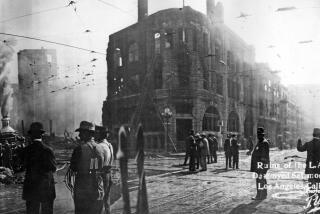Precision Timing Marks Bombers’ Attack
- Share via
RIYADH, Saudi Arabia — It was calculated down to a matter of seconds, and it unfolded in less than a minute.
The clock started ticking around 11:20 Monday night. With stopwatch precision, the American sedan -- accounts vary on whether it was a white Ford Crown Victoria or a gray Mercury -- drove up a narrow street to the guardhouse of the Vinnell Corp. compound, passing a sign on the high perimeter wall that warns, “Visitors must be escorted.”
Many expatriate compounds in the Saudi capital are well-guarded, and security at Vinnell was especially tight. The complex of low, sand-colored buildings -- mirroring the bleak landscape of Riyadh -- houses U.S. trainers for the Saudi National Guard, which protects the royal family.
Maybe the guards saw that it was an American car and didn’t react until it was too late. In a brief shootout, three guards armed with a .50-caliber machine gun atop a truck across the road from the guardhouse were killed or injured. Sentries in the guardhouse itself were overpowered; their fate was unclear. At some point, the shooters jumped from the sedan. Their job almost done, they lowered the barrier preventing entry.
A Dodge Ram truck then sped through, took the first left turn and drove a block to a four-story apartment building housing 70 trainers, mainly Americans. Finally, it took a quick right and stopped a few yards down the road -- at just the right point for maximum impact, according to a tentative reconstruction by U.S. military officials Tuesday.
Then the bomb inside the Dodge was detonated -- probably by the driver.
The explosion, estimated by the U.S. military to be the equivalent of a 400-pound bomb and probably made up of sophisticated material such as Semtex or RVX, sheared the face off the apartment building. Concrete, glass, furniture and sleeping inhabitants were hurled in all directions.
The explosive was compounded, allowing a small amount to have an impact far larger than its size. “It doesn’t produce a lot of noise, but it produces an incredible shock wave,” said a U.S. Army general at the site.
The explosion left a massive crater in the road at least 10 feet deep and 10 feet wide, according to U.S. military estimates.
Vinnell was the last of three bombings that shook Riyadh on Monday night. Within about a five-minute time frame, the explosions ripped through Vinnell and two other compounds for foreigners, killing at least 29 people -- including the bombers -- and injuring almost 200 others, according to U.S. military and Saudi officials.
The tight sequence of events, timed so no one attack might lead to alerts and lockdowns elsewhere in the capital, was meticulously planned, U.S. military and Saudi officials said.
The attacks involved extensive intelligence and almost certainly information from people who had been inside, because the target was the most populated building in the compound run by Vinnell, a Virginia-based company that has operated in Saudi Arabia for 29 years.
“It was a sophisticated, near-simultaneous attack -- they knew the setup,” the U.S. general said. “The modus operandi in the three was almost identical.”
A day later, the acrid stench of cordite still hung heavily in the air. With its front sheared off, the shattered apartment building brought to mind a giant doll’s house. The streets of the compound were thickly littered with glass shards, bits of concrete and steel, and odd pieces of furniture and goods that had been blown from the building.
Just walking the brutally strewn streets seemed an invitation for a tetanus shot.
The complex was eerily quiet, the only sound the wind blowing the debris of the bombing around. Every building and vehicle in the compound had been damaged, as were some buildings nearby, the U.S. military officials said.
A twisted American flag dangled high on the side of the building. Thick palm trees had been decapitated or snapped in half by the blast’s impact.
A few traces hinted at what the compound once looked like. Amid the rubble in the apartment complex was a large mirror, crooked but still intact on the top floor. Across the street, an undisturbed sign, in crisp blue letters, advertised a thrift shop “operated by the ladies of Vinnell Arabia.” But the building was in ruins.
Cloaked by tight security amid 100-degree heat, Secretary of State Colin L. Powell toured the site Tuesday as a fierce sandstorm howled. The sand whipped around, getting in eyes, mouths and noses, and forcing people to run for shelter.
Three dozen Saudi National Guard troops with green berets were deployed on the streets of the compound, and U.S. diplomatic security surrounded Powell, whose entourage included an ambulance.
Vinnell was hit harder than either of the other two compounds in northeast Riyadh, the Al Hamra Oasis Village and Jadawel, U.S. officials said.
“In terms of the physical damage and casualties, this was the worst, in part because this was much older architecture and construction. So the blast effect had much greater impact,” said the U.S. general who is assigned to assist the Saudi military.
But the human cost was even higher: All of the dead Americans were from Vinnell.
More to Read
Sign up for Essential California
The most important California stories and recommendations in your inbox every morning.
You may occasionally receive promotional content from the Los Angeles Times.













